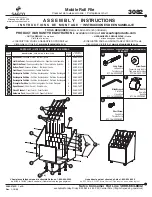
mc²36 MKII Installation & Service Guide
Version: 1.0/1
56/56
6. Appendices
6.5
SMPTE ST2022-7 (SPS)
SMPTE ST2022-7 is a method of recovering lost data packets when streaming data over an IP network. The
technology is also known as Seamless Protection Switching (SPS). Within a RAVENNA installation, it can be
used to provide main and redundant paths for audio/video streams and PTP synchronization.
Concept
The diagram below illustrates the concept in a standard data network:
A SMPTE ST2022-7-enabled transmitter duplicates the input stream and sends it via two different network paths
to the destination receiver. The receiver (also SMPTE ST2022-7-enabled) combines the data from both paths
and reconstructs the original stream. If a packet from path 1 is missing, then the packet is taken from path 2. If
path 1 is lost completely, then the entire stream is taken from path 2. And vice versa. The result is that the
receiver can switch from one path to the other without impacting upon the stream content.
The network class determines how much delay between the two paths can be tolerated. Class C devices have
an extended buffer size, and so can handle longer delays than Class A. Thus, Class C compatible devices can
cope with a larger network infrastructure.
Configuration
To configure SMPTE ST2022-7, you will need to create two separate paths in the Media Network. This means
doubling the network's infrastructure and then connecting each sending and receiving device to both paths.
Within Lawo systems, the two paths are usually known as the primary (red) and secondary (blue) networks.
For partnering connections between the Core and a remote IO device, the streams are created automatically by
the AdminHD configuration. For RAVENNA Tie-lines, the streams must be configured manually using the
device's Web UI.
In all cases, you
must
use an odd/even pair of ports to configure SPS. i.e. ports 1+2 or 3+4, but not 2+3!

































